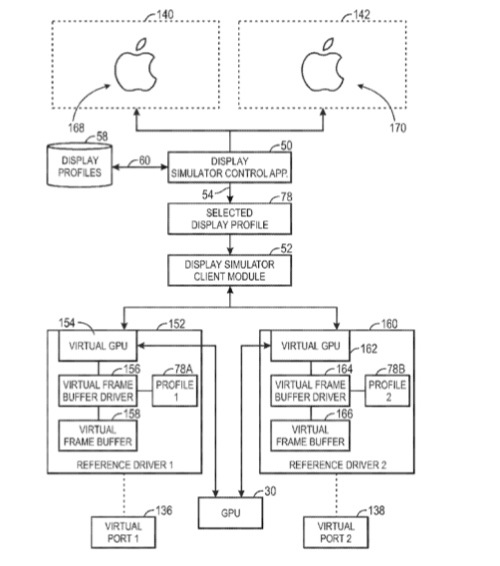Apple is apparently working on a new display standard, based on a patent (number 20100321395) for a display simulation system and method that has appeared at the US Patent & Trademark Office. It relates generally to display devices and, more specifically, to techniques for simulating display devices on a computing device.
A display simulation system is provided having a flexible design for emulating and/or supporting any number of display types and/or display standards. The display simulation system may include one or more reference drivers that include a virtual graphics processing unit (GPU) and one or more virtual frame buffer drivers.
In one embodiment, the display simulation system may implement a virtual display in response to a user selection input. For instance, the user selection input may initiate a simulated hot-plug event on the display simulation system. Based upon the user selection, an appropriate display profile corresponding to the selected display type or standard may be loaded by the display driver. In this manner, the display simulation system may provide for user interaction with the virtual display, such as for testing, verification, benchmarking, or development purposes. The inventors are Maciej Maciesowicz, Crol Lavelle, David A. Curran and Jiming Sun.
Here’s Apple’s background and summary of the invention: “As display technologies continue to advance, newer display standards are constantly being developed. However, due to the nature of the development cycle, the development and testing of software infrastructures for new display standards generally lags with respect to the hardware development. This is due at least partially to the fact that software development of drivers and related applications for a particular display standard is largely dependent on having a hardware platform available to perform proper testing, debug, verification, benchmarking, and so forth, of the software infrastructure.
“Further, due to the offset in the hardware and software development cycles, substantial progress in the development of software for a new display standard may, in some instances, occur only after the display hardware itself has been implemented. As such, software developers are given relatively little time to develop a fully functional software package for the new display standard before the hardware is introduced to the market. Additionally, even if software developers are able to provide a full software package that coincides with the introduction of a new display standard to the market, there may not have been sufficient time to fully test, debug, and/or verify the software and hardware infrastructures for the new display standard.
“A summary of certain embodiments disclosed herein is set forth below. It should be understood that these aspects are presented merely to provide the reader with a brief summary of these certain embodiments and that these aspects are not intended to limit the scope of this disclosure. Indeed, this disclosure may encompass a variety of aspects that may not be set forth below.
“The present disclosure generally relates to techniques for simulating displays in a computing system. In one embodiment, a display simulator application is provided having a flexible design for emulating and/or supporting any number of display types and/or display standards. The display simulator application may be configured to execute on a variety of platforms, and may provide one or more generic virtual display ports and reference frame buffer drivers.
“Depending on a display profile selected and/or provided by a user, a virtual display may be implemented by configuring the reference frame buffer driver (which may include a virtual graphics processing unit, a virtual frame buffer driver, and a virtual frame buffer), in accordance with the selected display profile. The reference frame buffer provides an abstraction layer, such that from the view point of an operating system, the virtual display appears as a physical display on the computing system. The display simulation system may, therefore, allow a user to interact with the virtual display, thus facilitating software testing, verification, benchmarking, and/or development.
“Various refinements of the features noted above may exist in relation to various aspects of the present disclosure. Further features may also be incorporated in these various aspects as well. These refinements and additional features may exist individually or in any combination. For instance, various features discussed below in relation to one or more of the illustrated embodiments may be incorporated into any of the above-described aspects of the present disclosure alone or in any combination. Again, the brief summary presented above is intended only to familiarize the reader with certain aspects and contexts of embodiments of the present disclosure without limitation to the claimed subject matter.”
— Dennis Sellers





